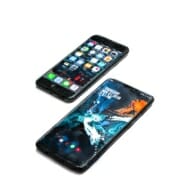iPhone App Development: Why You Should Partner With A Studio?
Apple has built one of the most prestigious smartphone brands in the industry — the iPhone. The first generation iPhone launched in 2007, and after multiple iterations of the product — and 17 years later — over 2.6 billion iPhones have sold worldwide. Undoubtedly, this makes it one of the most popular smartphones in existence. And why so many individuals and businesses are interested in iPhone app development.
But should you develop apps for the iPhone, and can you handle this yourself? Over 1.8 million paid and free apps are in the App Store, estimated to generate approximately US$112 billion during 2024. Thus, it’s a highly competitive market with plenty of opportunities to generate huge returns with the right app strategy. However, you shouldn’t tackle this market alone unless you’ve partnered with a trusted app development studio.
One of the main reasons why you don’t want to go at it alone is that navigating the iOS development landscape is tricky. It requires an excellent grasp of all the latest development tools, frameworks, and methodologies, which Apple constantly updates. You’ll likely make several costly mistakes, especially if you don’t have any prior experience with iOS or app development in general.
If you’re looking for a studio to partner with, consider NS804, an award-winning mobile app developer. We started our studio in 2012 and have completed over 100 apps for brands, businesses, and appreneurs. Furthermore, we specialize in building native mobile apps for iOS and Android, making us an ideal iPhone app development partner.
We understand that this doesn’t cover enough ground on the matter. Below, we reveal everything you should know about iOS development, its benefits, and what NS804 can offer you.
Is It More Beneficial To Develop For iOS Than Android?
If you want to release your app in North America, Norway, the United Kingdom, Japan, and Australia, it’s a sensible choice to target iOS over Android. That’s because there are more iPhone users in these territories than Android users. However, Android enjoys an increased market share in wealthy Western European countries like France, Germany, and the Netherlands.
Therefore, if you need international reach, you should still target Android. If there are budget constraints, build your iOS app first and see how it does in the local market. And if it does reasonably well, you can forge ahead with the Android build. One of the key benefits of the Android platform is that there are many third-party app stores, especially in Asian territories. So, if you want to target the massive Chinese app market, you’ll have no choice but to release it on Android.
While handling a build for one version of your app is challenging, two drastically increases that challenge. That’s especially true if you require native mobile versions for iOS and Android since this will result in better performance, consistent user interface (UI), and user experience. Furthermore, you’ll need to localize your app for each territory you target and optimize each app store’s page to increase organic searches.
There’s plenty of work involved and many potential roadblocks that can impede the progress of your app project. Now, you understand why we mentioned earlier that you shouldn’t tackle this alone. When you partner with NS804, we’ll help you every step of the way.
Whether you begin with Android or iPhone app development, we’ll guide you through every phase, from planning, development, and release. If necessary, we’ll also assist with the post-release phase, which includes maintaining and updating your app.
Is The iPhone A Good Platform For A Mobile Game?
Apple has always had a reputation for treating gaming as the poor stepchild of the family. However, the iOS platform unlocked plenty of opportunities for mobile game developers and even for some of the larger players in the industry. So, that’s a big yes from us. You should consider building a game for the iPhone, especially if you want to tap into its popular subscription service — Apple Arcade.
Apple Arcade isn’t only for iPhones but is available across all iOS and macOS (Catalina or later) devices. And if you take advantage of Game Center (a social network specifically for gaming), you can build deep and meaningful multiplayer experiences that work across multiple Apple platforms.
What’s great about this is that macOS users can engage and play with iPhone users in real-time. The matchmaking feature in Game Center will connect users for real-time or turn-based play sessions and match users based on their skill levels and other parameters.
While Game Center and the GameKit framework make life easier from a development standpoint, implementing robust network functionality always proves challenging. There’s nothing worse for users who want to play their favorite iOS game only to experience server connection issues, login errors, and crashes. But that’s more common than you’d think because some developers overlook their network code and fail to follow best practices.
That’s why, even if you attempt to build a simple iPhone game, consider working with a reputable studio. NS804 has experience developing fun and engaging games like Bat Flaps, Trivia Monsters, and Qwest Giver. But even if you only want gamification features in your next iPhone app development endeavor, we can assist with their implementation.
What Are The Benefits Of The iPhone App Development Environment?
Apple imposes stringent rules for developers who wish to submit their app for review and entry into the App Store. Undoubtedly, this is a good thing for users, as they will enjoy a certain quality threshold often lacking in competing app stores. Thus, developers must work harder to gain entry into Apple’s well-controlled yet lucrative walled garden.
As you can figure by now, cutting corners is a big no-no if you wish to have a long and successful iPhone app development career. But it’s also comforting to know that Apple has taken steps to make the development process less arduous, as follows:
- Modern programming language: In 2014, Apple introduced Swift as an upgrade to the aging Objective-C language. The advantage Swift brings to the table is more maintainable, safer code that’s easier to write. Many developers prefer to use Swift because it speeds up the development process.
- Excellent frameworks: Apple has introduced several frameworks that facilitate smoother development and allow developers to tap into the iPhone’s latest features. The only downside with these frameworks is there’s often a learning curve to utilize them to their full potential. Several popular frameworks include GameKit, SwiftUI, XCFramework, and many more.
- Service integrations: Apple offers several world-beating services like Apple Pay, Apple Maps, and Apple Fitness. Many users also love using Siri, the privacy-conscious digital assistant that responds to user requests with human-like responses. Apple’s tightly integrated development environment makes it easy for developers to include any of these services in their apps.
How To Create Stunning Visuals For An iPhone App?
Take a peek at the App Store, and you’ll see many modern iOS apps that look visually striking. The latest iPhone models are significantly more powerful than those of previous generations. Consider that the Apple A17 Pro (the SoC within the iPhone 15 Pro) includes a 6-core graphics processing unit (GPU) capable of hardware ray tracing — a feature only available on powerful desktop GPUs and gaming laptops until now.
But to take advantage of the extra grunt the latest iPhones offer, you must use the relevant application programming interfaces (APIs). To create the best possible visuals for your next app, you must use Apple’s proprietary Metal API. It’s similar to Microsoft’s DirectX and the Khronos Group’s Vulkan, so it allows developers low-level access to the GPU but only on Apple devices.
When you become familiar with Metal, you’ll be in that rarified position to create and manipulate 2D and 3D graphics effortlessly. You can also use its built-in shading language to create exciting special effects that won’t look out of place in a big-budget CGI movie. However, the shading language is based on C++14, a programming language renowned for its complexity and steep learning curve.
Therefore, to become a well-rounded iOS app developer, it’s best to know Swift, Objective-C, and C++14. But that may be too much for a busy appreneur or business leader who only wishes to release an iOS app that looks great. Instead, consider partnering with NS804, and we’ll handle all the complex aspects of iPhone app development for you.
The Bottom Line
Targeting the iOS platform to release exciting apps for the iPhone is a worthwhile endeavor for any appreneur or organization. iPhones will continue to sell well globally, increasing the user base and the demand for new apps. Contact NS804 today to learn how we can help you create the perfect iPhone app!












Leave a Reply
Want to join the discussion?Feel free to contribute!